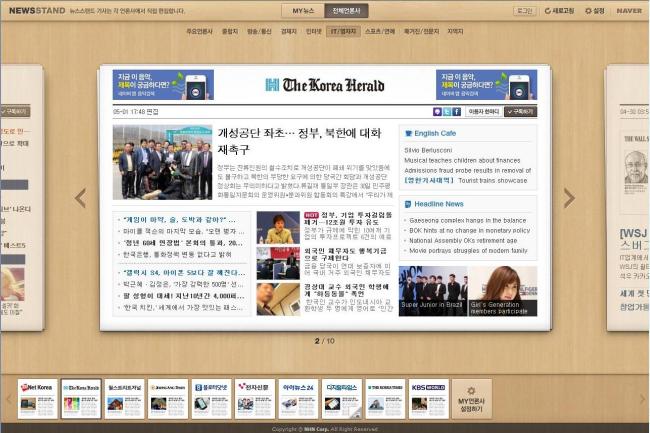 |
Naver Newsstand |
The online news service by Naver, Korea’s most influential Web portal, is seeing a major decrease in users one month after it introduced the new platform. The situation is hampering small news companies heavily dependent on the giant website.
In April, Naver adopted the “Newsstand” platform, which pooled the top pages of 53 major news outlets in Korea and presented them to the users. It replaced its predecessor “Newscast” system that randomly exposed articles from those 53 sources.
According to research firm Korean Click, the change in platform cut the number of total users to nearly one-fifth. In the first three weeks of its existence, the Newsstand attracted only 22.8 percent of users that the Newscast was able to draw.
As a result, the news websites that relied on Naver received a critical blow to their online traffic. The websites experienced at least a 50 percent drop in online traffic, and some small companies suffered an over 90 percent decrease.
The problem was that many Internet users complained that the new system was inconvenient because they have to first select the company, and then choose the article they want to see.
Both the Newscast and the Newsstand display only the headlines to the users, who are then redirected to the respective news websites when they click on it.
The reduced usage of the Newsstand platform directly affected the number of people visiting the websites linked to the service. The diminished online traffic is expected to lower the companies’ profits.
The disastrous impact on news websites was embodied in how much they depended on Naver-induced traffic. Korean Click said over the past three years, about 67 percent of news consumption occurred via the Newscast.
The prominent role of the Newscast was attributed to Naver’s dominance among Korean Internet users. Naver is estimated to account for 76 percent of search engine usage in Korea.
Among websites on the Newsstand, those of broadcasters were affected less, 38 percent decrease in the number of visitors. This is due to the fact that they had been relatively less dependent on the Newscast; the Naver traffic accounted for 20 to 50 percent of their traffic.
Internet media, which leaned predominantly on Naver, received a devastating blow of 65 percent decrease in visitors resulted by platform change.
Many news outlets are demanding Naver to come up with a strategy to regain the lost online traffic.
Naver, however, implied it is not looking to implement changes right away.
“We will observe the situation for six months and if there is a room for improvement, we will improve it,” said the company’s CEO Kim Sang-hun.
On comments that the Newsstand is not user-friendly, Kim said that inconvenience is a “concept that is relative,” and that the users will be comfortable using the new system once they get used to it.
By Yoon Min-sik
(
minsikyoon@heraldcorp.com)






![[Herald Interview] 'Trump will use tariffs as first line of defense for American manufacturing'](http://res.heraldm.com/phpwas/restmb_idxmake.php?idx=644&simg=/content/image/2024/11/26/20241126050017_0.jpg)
![[Exclusive] Hyundai Mobis eyes closer ties with BYD](http://res.heraldm.com/phpwas/restmb_idxmake.php?idx=644&simg=/content/image/2024/11/25/20241125050044_0.jpg)
